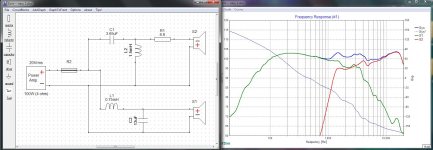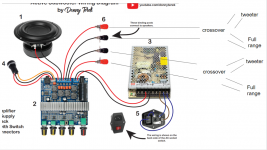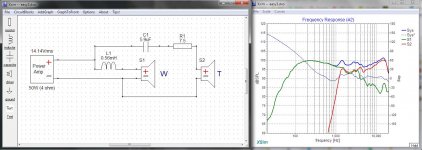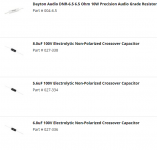No worries. I guess if you are using real measurements all the time there's no need to sim from the spec sheets.
FPGraphTracer : fprawn labs - Pretty quick and easy although it can get confused sometimes. Then I take the graph into MS paint and erase trouble spots around the desired curves. No time like the present, as they say........
FPGraphTracer : fprawn labs - Pretty quick and easy although it can get confused sometimes. Then I take the graph into MS paint and erase trouble spots around the desired curves. No time like the present, as they say........
FPGraphTracer : fprawn labs - Pretty quick and easy although it can get confused sometimes. .
Yep, most of what I've done is repair/upgrade level stuff and not a lot of raw design. So I'm thinking I've been a little spoiled...
Thanks. I'll start learning with it this afternoon.
Here is diagram of the wiring. (Sorry about the poor quality)
Okay... lets have a look and see what we can see...
I've got the driver behaviour files now, so it's possible to rough out a few different scenarios for you. (Thank you @Jreave)
It's obvious the Dayton crossover is not what you want.
First, the little 4 inch driver isn't going to deliver a lot of low bass, so you want to adjust your amplifier to cross over the sub-woofer at about 100hz and level match it with the satellites. The sub woofer will fill in the lower part of the bass for you. If you get the levels right, you won't even notice the change from satellite to sub.
Second, you are using a full range driver for your "satellites". If we look at the driver by itself, in the first thumbnail, I gotta tell you, that's not bad. No tweeter required. This would require you to simply hook the full range drivers up to the amplifier's left and right outputs directly. Which is what I would suggest you do.
Second, if you are finding the full range to be a bit weak in treble you can go with the second thumbnail, which still operates the 4 inch driver full range but adds a little boost from the tweeter. This is a very easy build, you can add the parts right onto the back of the tweeter, securing them with a little blob of silicon. You will, of course want to solder the connections. You can vary the teeter level by changing the value of the resistor... lower values will increase the tweeter level, higher values will reduce it.
Third, if you're up for a bit of a building chore, you can create a very basic crossover as shown in the third thumbnail. For this you would need to build the parts on a small perf board and mount it inside the speaker cabinet, running wires to your drivers. It's not difficult to make but it does involve soldering connections and a few extra parts. Please note R2 right on the input is not a part you add to your build. It is there to simulate the wire and let me read currents while designing.
I hope this is helpful...
Attachments
Last edited:
I have added the wiring diagram as an attachment. Sorry for the poor quality of it.A diagram showing exactly how you have this hooked up would help...
Attachments
Keep in mind that there is much about a speaker that an frd file or a measurement will not show.Which is what I would suggest you do.
Did you build an active or passive sub?
Your main amplifier board has a 100 watt output for a passive sub. It will hilariously overload an active one.
I believe it is a passive subwoofer. The amp is within the enclose for the subwoofers which has 3 channels. A left and right channel as well as a sub channel. Does this help?
Okay... lets have a look and see what we can see...
I've got the driver behaviour files now, so it's possible to rough out a few different scenarios for you. (Thank you @Jreave)
It's obvious the Dayton crossover is not what you want.
First, the little 4 inch driver isn't going to deliver a lot of low bass, so you want to adjust your amplifier to cross over the sub-woofer at about 100hz and level match it with the satellites. The sub woofer will fill in the lower part of the bass for you. If you get the levels right, you won't even notice the change from satellite to sub.
Second, you are using a full range driver for your "satellites". If we look at the driver by itself, in the first thumbnail, I gotta tell you, that's not bad. No tweeter required. This would require you to simply hook the full range drivers up to the amplifier's left and right outputs directly. Which is what I would suggest you do.
Second, if you are finding the full range to be a bit weak in treble you can go with the second thumbnail, which still operates the 4 inch driver full range but adds a little boost from the tweeter. This is a very easy build, you can add the parts right onto the back of the tweeter, securing them with a little blob of silicon. You will, of course want to solder the connections. You can vary the teeter level by changing the value of the resistor... lower values will increase the tweeter level, higher values will reduce it.
Third, if you're up for a bit of a building chore, you can create a very basic crossover as shown in the third thumbnail. For this you would need to build the parts on a small perf board and mount it inside the speaker cabinet, running wires to your drivers. It's not difficult to make but it does involve soldering connections and a few extra parts. Please note R2 right on the input is not a part you add to your build. It is there to simulate the wire and let me read currents while designing.
I hope this is helpful...
Thank you for all of the help!
I figured I would let you know how the situation has changed slightly. I removed the prebuilt crossover attached the tweeter and full range directly to the amp. This produced the results you would expect, decent sound but the tweeter seemed to be over whelmed. However, the sub woofer was still overwhelming when turned to high volumes. At any real loud volume the bass filter had to be turn down very low. I will also add in the detail that I had this same amp about a month ago with the same sub and different speakers and ended up blowing on me. It was replaced a no charge so i assume it was a manufacturing defect. The bass on the sub was not over whelming on the first amp. I'm not sure why there is a difference.
Now in response to your advice.
First off I don't understand the part where you talk about the sub. Do you mean just adjusting the bass filters on the amp?
Second, these options look awesome. Because I poorly researched crossover and speaker building in general I have already built the enclosures with the tweeter so I am inclined to utilize it. This is why I am thinking about the last two options.
Third, I tried designing my own crossover. It would be great if you could take a look at it and tell me how it looks. If I could build it or if I should stick to yours.
Thanks again!
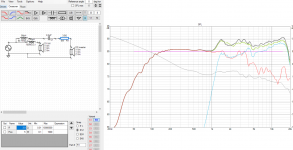
Last edited:
Thank you for all of the help!
I figured I would let you know how the situation has changed slightly. I removed the prebuilt crossover attached the tweeter and full range directly to the amp.
You should NEVER connect a tweeter directly to an amplifier's output. At anything louder than a quiet whisper you will almost certainly overheat and burn out the voice coil. They're not made to handle bass.
This produced the results you would expect, decent sound but the tweeter seemed to be over whelmed.
Because you were killing it. 😀
However, the sub woofer was still overwhelming when turned to high volumes. At any real loud volume the bass filter had to be turn down very low. I will also add in the detail that I had this same amp about a month ago with the same sub and different speakers and ended up blowing on me. It was replaced a no charge so i assume it was a manufacturing defect. The bass on the sub was not over whelming on the first amp. I'm not sure why there is a difference.
Unless they replaced your defective amp with another defective amp...
Also don't forget you were incorrectly driving a tweeter with the other two channels. The chip was probably in current limiting mode.
EDIT: something just occurred to me... Are you operating the satellite speakers outside the box, like sitting on a table?
Now in response to your advice.
First off I don't understand the part where you talk about the sub. Do you mean just adjusting the bass filters on the amp?
Yes... the bass frequency and bass level knobs on your amplifier.
Second, these options look awesome. Because I poorly researched crossover and speaker building in general I have already built the enclosures with the tweeter so I am inclined to utilize it. This is why I am thinking about the last two options.
Frankly I would suggest my second option with the capacitor and resistor in series with the tweeter. It is very easy to build and they do sound ok.
Third, I tried designing my own crossover. It would be great if you could take a look at it and tell me how it looks. If I could build it or if I should stick to yours.
A couple of things ...
First lose the coil in series with the tweeter. It is of such low value as to make no difference and there's no reason for it to be there.
Second the coil on the woofer could be a fair bit larger to bring it's level down above the tweeter's crossover point.
All in all not bad for a first attempt.
I've included an adjusted version of your design in the thumbnails.
Allow me to recommend that you take my second option... run the full range driver in full range and add the cap and resistor to power the tweeter. As I explained you can play with different resistor values to adjust the trebble.
Attachments
Last edited:
I’ll stick with your second option. It sounds like A good plan especially because of my inexperience. Thank you for all of your help! You learn something new every day and I hope I didn’t permanently damage my tweeter.
One last question for now:
The channels with my amp are 50watt 4 ohm. The full range drivers have an impedance of 4 ohms, Power Handling (RMS) of 30 Watts and a Power Handling (max) of 60 Watts. The tweeters have an impedance of 4 ohms and a Power Handling (RMS) of 25 Watts. With your second option will this all work together?
One last question for now:
The channels with my amp are 50watt 4 ohm. The full range drivers have an impedance of 4 ohms, Power Handling (RMS) of 30 Watts and a Power Handling (max) of 60 Watts. The tweeters have an impedance of 4 ohms and a Power Handling (RMS) of 25 Watts. With your second option will this all work together?
Last edited:
I’ll stick with your second option. It sounds like A good plan especially because of my inexperience. Thank you for all of your help! You learn something new every day and I hope I didn’t permanently damage my tweeter.
Me too ... Best of luck finishing the project.
The channels with my amp are 50watt 4 ohm. The full range drivers have an impedance of 4 ohms, Power Handling (RMS) of 30 Watts and a Power Handling (max) of 60 Watts. The tweeters have an impedance of 4 ohms and a Power Handling (RMS) of 25 Watts. With your second option will this all work together?
It should. There is less musical energy above about 5khz, so less power is needed for the tweeter... plus you are attenuating it with a resistor.
But... do let me warn you. Overdriving an amplifier into what is called "clipping" can and does fry tweeters. This happens because when an amplifier clips it is taking off the rounded tops of the musical waveform, resulting what looks like square waves and square waves have a lot of harmonics that get way up into tweeter territory and can overheat it.
Sooooo...😀 ... use the volume control wisely.
Again, best of luck finishing off...
It can Douglas, but apparently it may not be the sole or primary cause.Overdriving an amplifier into what is called "clipping" can and does fry tweeters.
You may be interested in this (several pages long!) analysis from the University of St Andrews, Scotland's first university founded in 1413. 🙂
Amplifier clipping and tweeter damage
A very interesting read. Thank you.
I don't think I ever believed it was solely harmonics. The treble still gets amplified as the article shows.
Put the two together and poof!
I wasn't doing audio service back when the loudness war began, but a friend of mine tells a story about how they were running around for weeks on end doing almost nothing but replacing blown tweeters. It makes sense when you consider what would happen if you clipped "music" with almost 0 dynamic range, sourced at many times the standard Consumer Line Level.
I don't think I ever believed it was solely harmonics. The treble still gets amplified as the article shows.
Put the two together and poof!
I wasn't doing audio service back when the loudness war began, but a friend of mine tells a story about how they were running around for weeks on end doing almost nothing but replacing blown tweeters. It makes sense when you consider what would happen if you clipped "music" with almost 0 dynamic range, sourced at many times the standard Consumer Line Level.
Last edited:
I should be using non polarized capacitors for this "crossover", correct?
Yes, absolutely ... rated for 50v or more.
This is what I'm Planning on buying. Does this look ok? Thanks!
Yep... looks fine.
- Home
- Loudspeakers
- Multi-Way
- Crossover issue (I think)

